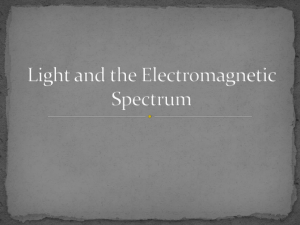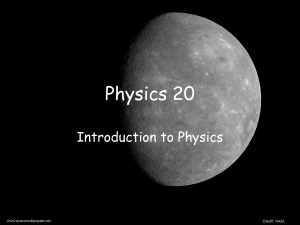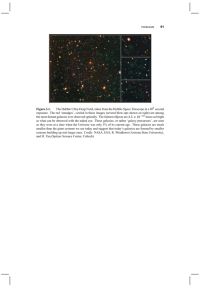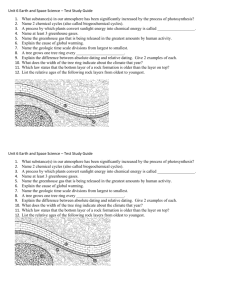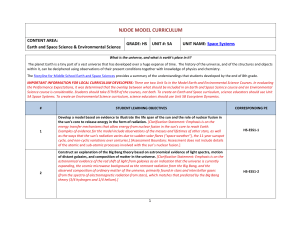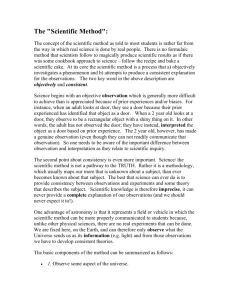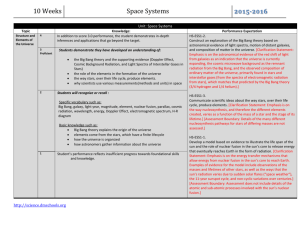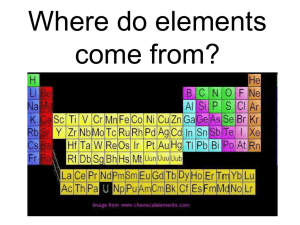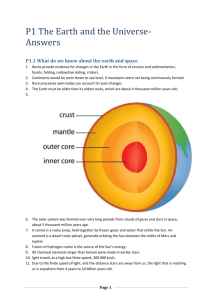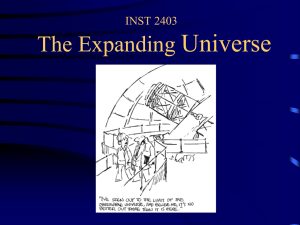Astronomy – Phys 181 – Midterm Examination
advertisement
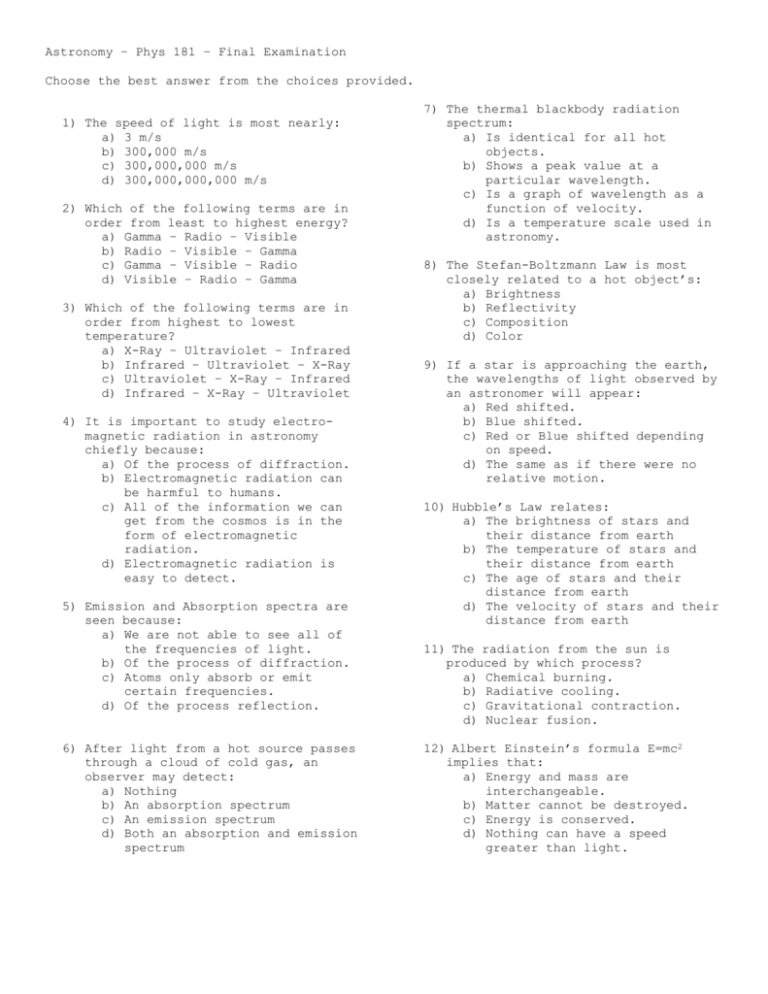
Astronomy – Phys 181 – Final Examination Choose the best answer from the choices provided. 1) The speed of light is most nearly: a) 3 m/s b) 300,000 m/s c) 300,000,000 m/s d) 300,000,000,000 m/s 2) Which of the following terms are in order from least to highest energy? a) Gamma – Radio – Visible b) Radio – Visible – Gamma c) Gamma – Visible – Radio d) Visible – Radio – Gamma 3) Which of the following terms are in order from highest to lowest temperature? a) X-Ray – Ultraviolet – Infrared b) Infrared – Ultraviolet – X-Ray c) Ultraviolet – X-Ray – Infrared d) Infrared – X-Ray – Ultraviolet 4) It is important to study electromagnetic radiation in astronomy chiefly because: a) Of the process of diffraction. b) Electromagnetic radiation can be harmful to humans. c) All of the information we can get from the cosmos is in the form of electromagnetic radiation. d) Electromagnetic radiation is easy to detect. 5) Emission and Absorption spectra are seen because: a) We are not able to see all of the frequencies of light. b) Of the process of diffraction. c) Atoms only absorb or emit certain frequencies. d) Of the process reflection. 6) After light from a hot source passes through a cloud of cold gas, an observer may detect: a) Nothing b) An absorption spectrum c) An emission spectrum d) Both an absorption and emission spectrum 7) The thermal blackbody radiation spectrum: a) Is identical for all hot objects. b) Shows a peak value at a particular wavelength. c) Is a graph of wavelength as a function of velocity. d) Is a temperature scale used in astronomy. 8) The Stefan-Boltzmann Law is most closely related to a hot object’s: a) Brightness b) Reflectivity c) Composition d) Color 9) If a star is approaching the earth, the wavelengths of light observed by an astronomer will appear: a) Red shifted. b) Blue shifted. c) Red or Blue shifted depending on speed. d) The same as if there were no relative motion. 10) Hubble’s Law relates: a) The brightness of stars and their distance from earth b) The temperature of stars and their distance from earth c) The age of stars and their distance from earth d) The velocity of stars and their distance from earth 11) The radiation from the sun is produced by which process? a) Chemical burning. b) Radiative cooling. c) Gravitational contraction. d) Nuclear fusion. 12) Albert Einstein’s formula E=mc2 implies that: a) Energy and mass are interchangeable. b) Matter cannot be destroyed. c) Energy is conserved. d) Nothing can have a speed greater than light. 13) The process of Gravitational Equilibrium results in: a) Stars roughly the same size as our sun. b) Supernova explosions. c) Stellar temperature regulation. d) Sun spots. 14) In order to determine the proper motions of stars, one must observe: a) The Doppler shift and angular motion. b) The Doppler shift and luminous intensity. c) The luminous intensity and angular motion. d) The parallax and luminous intensity. 15) A change in apparent magnitude by 5 corresponds to a change in apparent brightness of: a) 10 b) 100 c) 1000 d) 10000 16) The order of spectral classification of stars is based on: a) Temperature b) Brightness c) Apparent magnitude d) Red shift 17) On the H-R Diagram shown, a very high mass star will spend most of it life in what region? D L U M I N O S I T Y C 19) On the H-R Diagram shown above, the diagonal line represents: a) The division between high and low mass stars b) The division between high and low temperature stars c) The evolution of stars like our own Sun d) The Main Sequence 20) Our Sun will eventually evolve into: a) A Blue Giant b) A Red Giant c) A White Dwarf and planetary Nebula d) A Supernova Explosion 21) Neutron stars are the result of: a) Supernova explosions b) Main sequence burning c) Black holes d) Accretion 22) Unknown to Newton, it is now understood that gravity is due to: a) Rapid rotation b) Space-Time curvature c) Electro-magnetic Radiation d) Mass 23) The General Theory of Relativity is based on what principle? a) The constancy of the speed of light b) E=mc2 c) Equivalence d) Universal Gravitation 24) It is known that the type of galaxy we live in is: a) Spiral b) Elliptical c) Irregular d) Barred spiral A 25) The largest fractions of galaxies in our universe are: a) Spiral b) Elliptical c) Irregular d) Barred spiral B O B A F G K M 18) On the H-R Diagram shown, where are you most likely to find a white dwarf star? 26) The special theory of relativity is based on the notion that: a) The speed of light is the ultimate speed b) The speed of light should be measured to be the same by all observers c) Gravity is caused by curved space-time d) The Doppler shift is true for light waves. 27) In the “twin paradox” experiment: a) Twins age at the same rate b) A twin who travels ages slower c) A twin who travels ages faster d) Twins experience different amounts of gravity. 28) The planet Pluto is 5 light-hours away. If you travel in a rocket to Pluto, from you point of view, the trip will take a) More than 5 hours b) Exactly 5 hours c) Less than 5 hours d) Impossible to determine 29) The size of the universe and the age of the universe are related by: a) The speed of light b) Hubbles’ law c) Kepler’s law d) Relativity 30) The apparent brightness of a star is proportional to: a) One over the distance b) One over the square of the distance c) One over the luminosity d) One over the square of the luminosity 31) The to: a) b) c) d) term Cepheid Variables refers White dwarfs Elliptical galaxies Distance standards Any periodic light source 32) Olber’s paradox indicates that: a) Our universe is finite and expanding b) Our universe is infinite c) Our universe has very few stars in it d) Our universe is old 33) Hubble’s law is based on the observation that: a) Far away objects are more red shifted b) The universe is finite c) The universe is infinite d) The universe is relatively constant in size.
